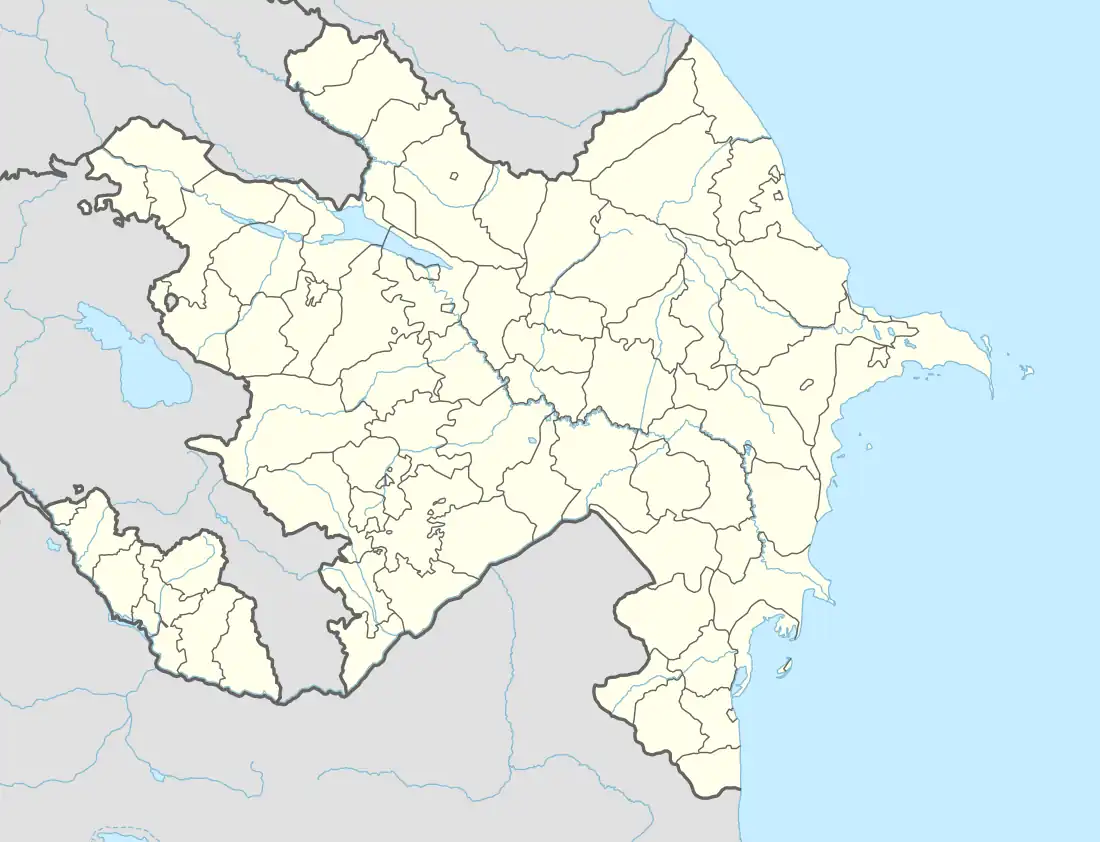| Haji Shahla Mosque | |
|---|---|
Azerbaijani: Hacı Şəhla məscidi | |
 The mosque in 2019 | |
| Religion | |
| Affiliation | Islam |
| Status | restored |
| Location | |
| Location | Balakhany, Baku, Azerbaijan |
 Location within Azerbaijan | |
| Geographic coordinates | 40°27′49″N 49°55′12″E / 40.463719°N 49.920087°E |
| Architecture | |
| Architect(s) | Ustad Arif, Musa Jibal |
| Style | Islamic architecture, Architectural school of Shirvan-Absheron |
| Founder | Haji Shahla bin Shakir bin Mustafa Koshki |
| Completed | 1385-1386 |
Haji Shahla Mosque (Azerbaijani: Hacı Şəhla məscidi) Hacı Shahla Mosque is an architectural monument dating back to the 14th century located in the Balakhany town of Baku. The inscription on the mosque indicates that it was built in 1385-1386 by the order of Hacı Shahla bin Shakir bin Mustafa Köşkin and constructed by the master architect Arif, son of the master Musa Jibal.
After Azerbaijan regained independence, the building was included in the list of significant immovable historical and cultural monuments of the country by the decision numbered 132 of the Cabinet of Ministers of the Republic of Azerbaijan on August 2, 2001.
History
The Haji Shahla Mosque was constructed in the years 1385-1386[1] during the Shirvanshah period on a high hill in the cemetery of the Balaxanı village.[2] The mosque consists of an entrance portal and an interior chamber. Above the entrance gate, a two-line inscription reads:[3]
This structure belongs to Haji Shahla, son of Shakir, son of Mustafa Koshkin. Year seven hundred and eighty-seven (787) 1385/86.
Slightly to the left of this inscription, a smaller inscription placed a bit apart from the doorframe reveals the name of the master who built the mosque. This two-line inscription reads: "Constructed by Master Arif, son of Master Musa from Jibal." It's noteworthy that the inscriptions on it refer to the mosque as a "mansion."[3]
In 1918, the atrocities committed by Armenian Dashnaks during the March massacres continued in the Balaxanı village. The village community defended themselves from the enemy by fortifying the hill where the mosque is located. After this event, the hill on which the mosque stood was referred to as "sangar" by the residents of the village.
Soviet occupation
After the Soviet occupation, an official campaign against religion began in 1928. In December of that year, the Azerbaijan Communist Party Central Committee transferred many mosques, churches, and synagogues to educational clubs for their use in enlightening directions. If in 1917 there were 3,000 mosques in Azerbaijan, by 1927, this number reduced to 1,700, and by 1933, it dropped to 17.[4]
Following this, many mosques were closed down and left unused, resulting in their deterioration and destruction.
After Azerbaijan's independence
After the restoration of Azerbaijan's independence, the mosque was included in the list of significant immovable historical and cultural monuments of the country, according to Decision No. 132 of the Cabinet of Ministers of the Republic of Azerbaijan dated August 2, 2001.[5][6]
In 2017, the Haji Shahla mosque was restored with financial support from philanthropists among the residents of the Balakan settlement. The restoration works were carried out under the supervision of specialists from the State Service for Protection, Development, and Restoration of Cultural Heritage under the Ministry of Culture. During the restoration of the monument, bullet traces from the battles during the March Massacre were preserved on the walls of the historical building.[7]
See also
References
- ↑ Щеблыкин, И.П. (1943). Памятники Азербайджанского зодчества эпохи Низами (in Russian). Bakı: Изд-во АзФАН. p. 33.
- ↑ "Hacı Şəhla məscidi bərpa olunub". medeniyyet.az. Retrieved 2023-11-20.
- 1 2 "Hacı Şəhla məscidi bərpa olunub". azertag.az. AzərTac. 2019-01-08. Archived from the original on 2021-02-24. Retrieved 2019-07-10.
- ↑ Arif Yunusov (2004). Ислам в Азербайджане (PDF). Bakı: Zaman. p. 78. ISBN 9952-8052-0-9. Archived (PDF) from the original on 2023-07-05. Retrieved 2022-12-30.
- ↑ "Azərbaycan Respublikası Nazirlər Kabinetinin 2001-ci il 2 avqust Tarixli 132 nömrəli qərarı ilə təsdiq edilmişdir" (PDF) (in Azerbaijani). mct.gov.az. 2001-08-02. Archived from the original (PDF) on 2021-07-07. Retrieved 2023-11-02.
- ↑ "Ölkə və yerli əhəmiyyətli Memarlıq və Arxeoloji abidələr". sabunchu-ih.gov.az. Retrieved 2023-11-20.
- ↑ ONA.az (2021-03-31). "Balaxanıda erməni vəhşiliyi, güllələnmiş məscid - 31 MART GERÇƏKLƏRİ - VİDEO". ONA. Retrieved 2023-11-20.
